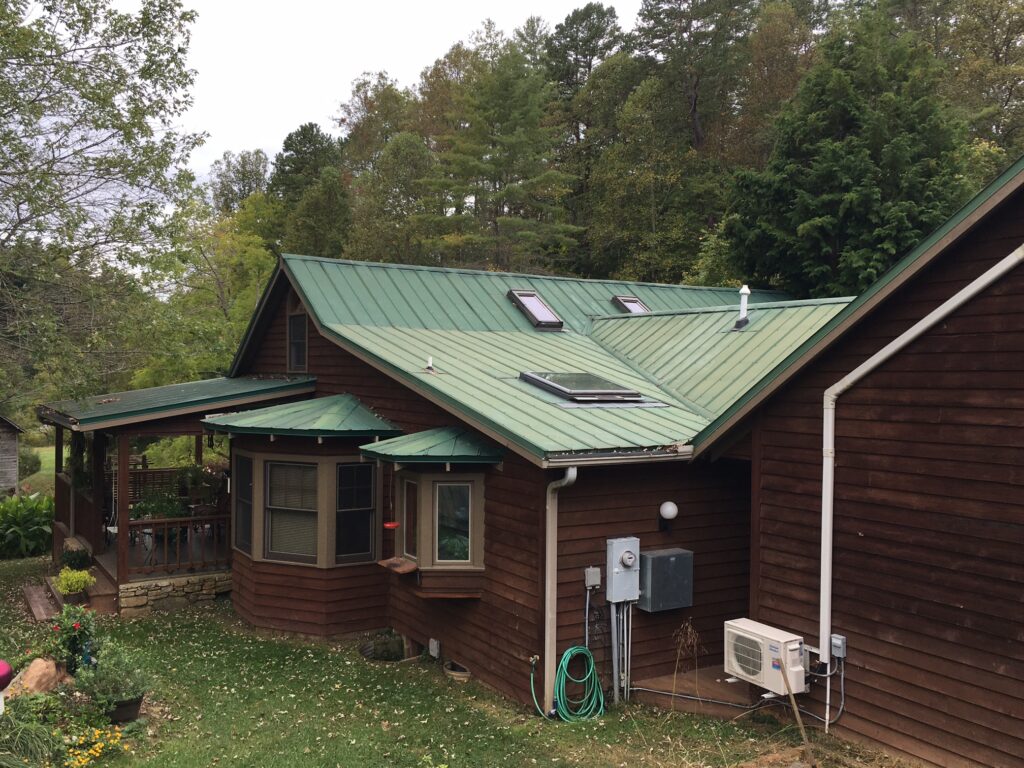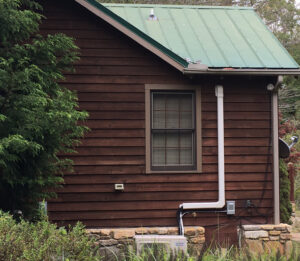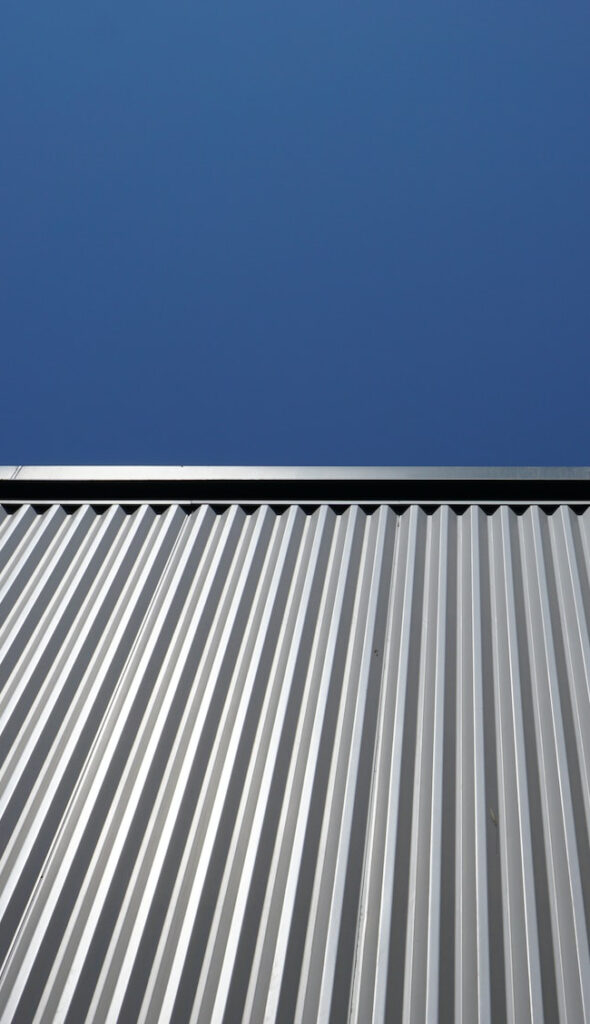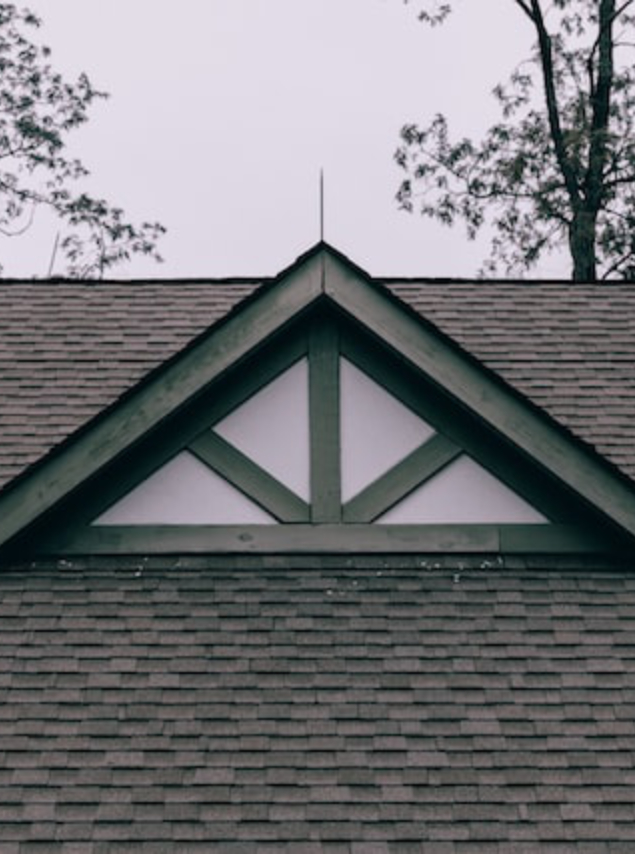
Photo by Hank Eder
If you’re in need of roof replacement, you may be asking yourself, “Should I install asphalt shingles again, or should I get a metal roof?” Perhaps you’ve already asked your roofer for two quotes so you can compare the two choices. The question isn’t so simple, and there are several factors to consider before deciding, as well as some pros and cons of both. First, let’s compare types of metal and shingle roofs.
Heavy metal!

Photo by Hank Eder
One type of metal roofing is called standing seam. There are two types in this category. True standing seam are long, flat panels in which the fasteners that attach to your home’s frame are hidden underneath. This type of metal roof is very durable and energy-efficient.
The second type of standing seam roof has exposed fasteners. This type is far more prevalent than the hidden panel variety these days.
Another type is called a corrugated metal roof. These have exposed, visible fasteners. These strong, durable panels display a repeating wave pattern. Most of the time, corrugated metal roofs cost less in labor costs than their standing seam counterparts. These are used mostly for sheds and barns, rather than homes.
Hitting the asphalt
Generally, two types of asphalt shingles are used in roofing. The first is known as three-tab shingles. Three-tab shingles are the most commonly used because they are the least expensive. However, the expression, “you get what you pay for,” applies here. These shingles are thin and offer less protection against heavy winds and hail. They have a shorter manufacturer’s warranty than asphalt architectural shingles. If you’re on a low budget, you might find them appealing, but expect them to wear out sooner.
Asphalt architectural shingles are your other option. They’re thought of as a higher-end variety of asphalt roofing shingles. Also known as dimensional or laminated shingles, they are made by layering two shingles together to create a layered, 3-D look. Because there are two layers, they are more durable than their three-tab cousins, resulting in longer life expectancy and a longer warranty.
All of these mentioned are valid choices for replacing your roof, but each situation differs according to each homeowner’s needs. Let’s dive a bit deeper into the pros and cons of each method, starting with metal roofing.
Metal roof pros and cons
In recent years metal roofs have become very popular for both residential and commercial uses.

Photo by Saj Shafiqueon Unsplash
Metal Roof Pros
The most appealing pro of a metal roof is its lifespan. Metal roofs are tough, and most warranties begin at 40 years. Some cover 50 to 60 years, but under the right conditions metal roofs can last even longer.
If you’re looking to stay in your “forever home,” a metal roof may be your “set it and forget it” roofing solution.
Another big plus is that metal is solar reflective, which means it pushes the sun’s heat away from your home. This means greater energy efficiency, especially during the heat of summer.
In addition, metal roofs are environmentally friendly. Metal is a 100% recyclable material. Every single metal panel on a roof can be repurposed for other uses, making it a favorite of “green-minded” consumers.
Finally, some roofers install metal roofing using “layover installation.” The new material is laid directly over the old material (a shingle roof, for example). This brings down labor costs related to tear-down and disposal. People on a really tight budget may opt for this, but we don’t recommend it, nor do manufacturers of metal roofing. If there is damaged plywood beneath the existing layer, it would not show up during layover installation.
Another reason that most manufacturers do not allow a metal roof to be installed over an old shingle roof is due to condensation between the metal and the shingle roof which will corrode the metal roof. Typically a spacer such as 1×4’s would need to be installed to provide air space. Be wary of roofers who want to do a layover installation without using spacers.
Metal Roof Cons
Higher Upfront Cost: Metal roofs cost more than asphalt shingle roofs. The cost of installing one may be double that of shingles. Throw in the longevity factor and metal is actually more cost effective, but many people are put off by the upfront costs of a metal roof.
Fewer Qualified Contractors: Most roofing contractors don’t have the tools and experience to install a metal roof. Those who do may be hard to get any time soon, since they likely have a long waiting list.
HOA Troubles: If you live in a housing development governed by a home owners association, you may not have the option of installing a metal roof. If the look of a metal roof or the color doesn’t match the rules of the neighborhood, the HOA will put the kibosh on it. Always talk to them first before spending your hard-earned money on a project that will get shut down.
Damage: While far more durable than their shingle counterparts, metal roofs are not invincible. Some are susceptible to corrosion and changes in patina. Very large hail may dent a metal roof, while still leaving it functional structurally. Many insurance carriers will not cover roof replacement when the roof is functional. However, metal roofs are quite strong, and most hail storms will not affect them.
Asphalt pros

Photo by Edgar Moran on Unsplash
More Contractors: There are far more contractors available who install standard asphalt shingle roofs. This means a shorter waiting period than for metal roofs. Be sure you shop around and check references to find a reliable contractor in your area.
Lower Upfront Cost: Asphalt shingle roofs run about half the cost of a metal roof. For this reason, they are far more common than metal roofs. They do offer excellent protection at a greater value, particularly the architectural shingle variety.
Warranty: Manufacturer warranties differ (some 10, some 15 years). You can even find roofing contractors that are certified by manufacturers such as Owens Corning. This ensures a higher level of workmanship, as well as a greater likelihood of actual warranty coverage once your roof has been installed.
Asphalt Cons
Lifespan: Asphalt is significantly weaker than metal, and will suffer greater damage over time from heavy rain, hail, snow, and wind. Metal roofs can last an owner’s lifetime, while asphalt may need several complete replacements during that time.
Limited Colors: Asphalt shingles offer very limited color choices, and they are not paintable. Metal roofs can be painted to any color imaginable, a great feature for businesses that want their buildings visually branded.
Poor Recyclability: It is very difficult to recycle asphalt shingles, and most will inevitably end their life in a landfill and take “forever” to break down. As mentioned earlier, metal roofs are 100% recyclable. Therefore, if environmental issues are important to you, this is a factor to weigh in your decision.
What Is the Verdict?
The choice of metal or asphalt for your next roof replacement is not always easy, but is mostly dependent on your budget, your needs, and your values. While metal roofs can cost twice as much as shingles, the longevity factor is something to consider. If you plan to stay in your home and pass it on to your children, a metal roof will be more cost-effective in the long haul.
Click here to see an article about roof replacement costs.
Buying or selling a home?
Avoid unpleasant surprises! Contact Asheville Home Inspector Peter Young before signing any contracts. Call (828) 808-4980, or click here to make an appointment.